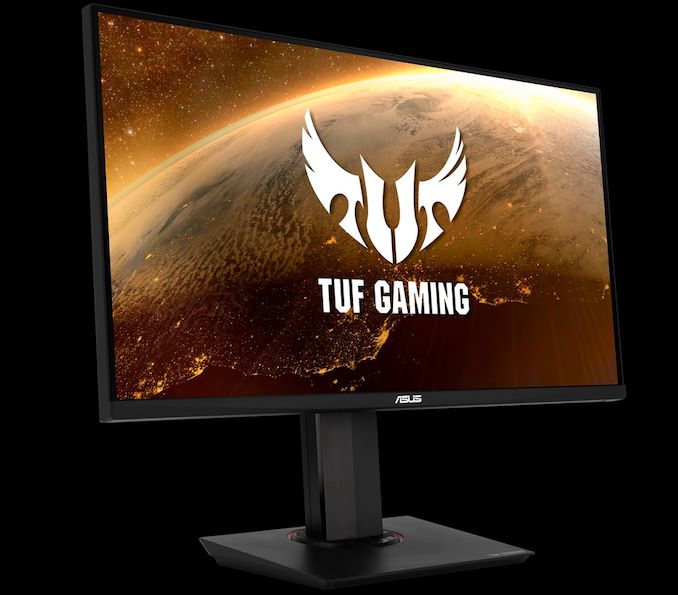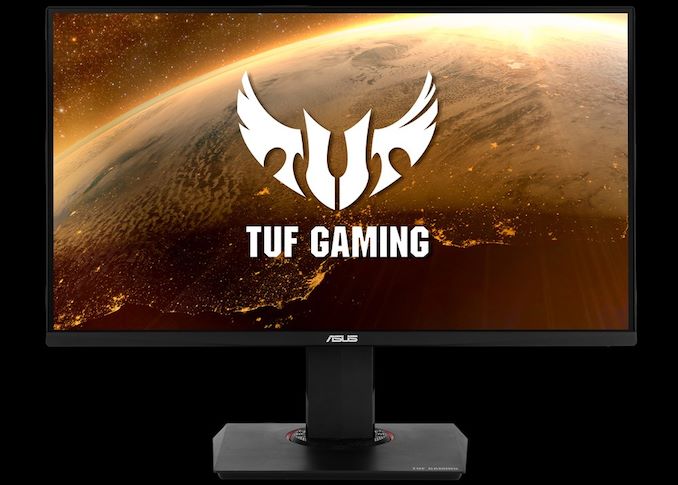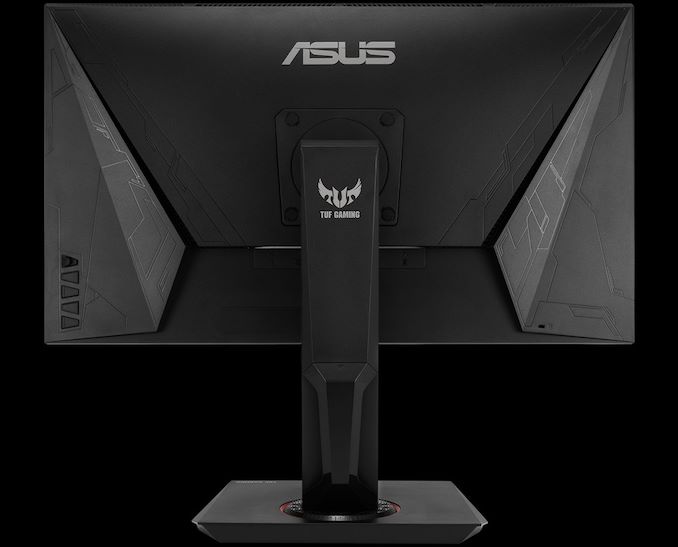28-Inches of TUF Gaming: The ASUS VG289Q 4K IPS Monitor w/ DCI-P3 & FreeSync
by Anton Shilov on November 15, 2019 5:00 PM EST
ASUS has introduced a new TUF-series monitor, which is designed for mainstream gamers who need a quality monior with support for major features, but are not necessarily interested in extreme performance. The TUF Gaming VG289Q combines all the main selling points of modern gaming displays: a large screen size with a 4K resolution, AMD’s FreeSync variable refresh rate, and DCI-P3 as well as HDR support.
Based on a non-glare 28-inch IPS panel, the ASUS TUF Gaming VG289Q has a 3840×2160 resolution, 350 nits peak luminance, a 1000:1 contrast ratio, 178°/178° viewing angles, a 5 ms GtG response time, and a 60 Hz refresh rate. Overall then, ASUS seems to be covering their bases by building a modest monitor around a solid 28-inch panel, but not chasing high-end features like high refresh rates that quickly drive up the price of a monitor.
Meanwhile, the TUF Gaming VG289Q monitor can display 1.07 billion colors and covers 90% of the DCI-P3 color gamut, something that will please multimedia enthusiasts. The LCD also technically supports HDR modes — the ASUS Multi HDR (for games and movies) mode as well as the HDR10 mode — although its peak brightness is too low for HDR, so the actual HDR user experience is something that remains to be seen.
Because the TUF VG289Q is designed for gamers, it inherits pre-set display modes for gaming, including genre-specific Gamevisual presets, Gameplus overlays (crosshair, time, FPS counter), and Shadow Boost feature that makes darker areas lighter without overexposing bright areas within a scene.
As far as connectivity is concerned, the ASUS TUF VG289Q has one DisplayPort 1.2, two HDMI 2.0 ports, and a headphone jack, an essential set of connectors to plug-in a PC and a couple of game consoles. Meanwhile, the monitor comes with a stand that can adjust height, swivel, tilt, and orientation.
ASUS has not announced pricing of its TUF Gaming VG289Q display, but considering positioning of the TUF brand and characteristics of the LCD, the product should be priced reasonably for a 28-incher. As for its launch date, the monitor should become available in the near future.
| ASUS TUF Gaming VG289Q | ||
| General Specifications | ||
| Panel | 28" IPS with non-glare coating | |
| Native Resolution | 3840 × 2160 | |
| Maximum Refresh Rate | 60 Hz | |
| Dynamic Refresh Rate | AMD FreeSync (40 Hz ~ 60 Hz?) | |
| Response Time | 5 ms (gray-to-gray) | |
| Brightness | 350 cd/m² | |
| Contrast | 1000:1 | |
| Viewing Angles | 178°/178° horizontal/vertical | |
| Color Gamut | 90% DCI-P3 | |
| Pixel Pitch | 0.1614×0.1614 mm | |
| PPI | 157 PPI | |
| Inputs | 1 × DisplayPort 1.2 2 × HDMI 2.0 |
|
| Audio | 3.5-mm headphone jack | |
| Color | Black | |
| Power Consumption | Standby | 0.5 W |
| Maximum | 65 W | |
| Additional Information | Link | |
| Price | ? | |
Related Reading:
- AOC Introduces Its G2868PQU Monitor: An Inexpensive 4K Gaming Display with FreeSync
- LG Launches 32QK500-W QHD Display: IPS and Freesync for $300
- LG Unveils 32UK550: 31.5 Inch 4K Display with DCI-P3, HDR10, & FreeSync for $500
- ASUS Displays New TUF Gaming Products
- CES 2019 Quick Byte: Ryzen 7 3750H inside the ASUS FX505DY TUF Gaming with 120 Hz Freesync
Source: ASUS (Hermitage Akihabara)














23 Comments
View All Comments
EliteRetard - Friday, November 15, 2019 - link
Why?28" 4k 60Hz monitors have already been around for like 5 years.
This brings absolutely nothing new or interesting, why introduce it at all?
Unless they are reducing the retail price to the common sale price around $200.
nevcairiel - Friday, November 15, 2019 - link
I agree, it lacks proper HDR brightnessm and the specs are nothing special for this day.I wish they would make a proper 27/28" 1440p 144Hz+ HDR1000 screen instead (16:9 and non-curved please), that seems to be a gap in the market as everyone is doing 4K now.
nevcairiel - Friday, November 15, 2019 - link
For example the Acer Predator X27 had excellent HDR brightness, but its 4K and as such limited by DP/HDMI bandwidth, and it also fell short in some other categories - unfortunately.thegpuguy - Tuesday, August 25, 2020 - link
First of all, the human eye could not see HDR1000 on a 28' fully - it would be to bright and have to be toned down and second, true cinema HDR1000 needs dynamic lighting zones which would be nearly 1500.00+ and 2 monitors have this spec exist.for Consoles and Affordable 4K content this is price point and IPS panel is amazing
Killshotgn - Friday, November 15, 2019 - link
4k 60hz isn't ideal for a lot of people. If you play any competitive games you are better served by higher refresh rates. 1440p 144hz is a great middle ground being easier to push higher frames with while offering very noticeably better visuals then 1080p. I personally would almost always take a good 1080p or 1440p 144hz screen over a 4k 60hz.flyingpants265 - Friday, November 15, 2019 - link
1440p 144hz is what we should all be aiming for, or even 120hz for now. That's about 4x more data than 1080p 60z, or almost 2x at 60hz. 4k was purely for movies, and apparently nobody even cared about 4k blu-rays..TEAMSWITCHER - Sunday, November 17, 2019 - link
If you play competitive games, you should be turning off all the advanced rendering, which means that image quality isn't a factor.. and the "High Refresh Rate" displays with their crappy panels, and single back light are great for you..But if the games you play are more "atmospheric" rendering quality and eye candy are what you SHOULD be focusing on. Even with an RTX 2080ti these features can drop framrates way below 144 fps.. often below 80 fps.. In this case you are far better off with a 60fps 4K TV with local dimming than a crappy PC display. Most PC's have a crappy IPS displays, with terrible black levels.. I mean .. THEY SSUUCCKK!! If you care at all about image quality, those high FPS displays will do nothing but provide more crappy images every second..
lilkwarrior - Monday, November 18, 2019 - link
You’re better off with a HDMI 2.1 OLED TV ATM, LG’s C9+ w/ G-SyncZoolook13 - Wednesday, November 20, 2019 - link
It has no G-sync module, please don't fall for Nvidias tricks.It's HDMI VRR, it could just as easily have been Freesync branded.
lilkwarrior - Monday, November 18, 2019 - link
Those are all high-end feature you listed. This isn’t a high end display.If it were it would be a ROG monitor w/ HDR1000, 4K@144hz via DSC, & MiniLED or OLED. That monitor is easily $1500+. Asus already have a $2000 monitor providing this for almost 2 years now.
Next year they have proper successors such as the PA32UCG wi/ 1152 MiniLED zones, HDR1400 (monitor actually goes 1600 nite, HDMI 2.1 VRR, Thunderbolt 3, & actually proper HDR formats support to take advantage of those nits with Dolby Vision, HLG, & HDR10